Overtourism and Medium Scale Sporting Events Organisations—the Perception of Negative Externalities by Host Residents
Abstract
1. Introduction
1.1. Negative Implications of Sporting Events and Overtourism
1.2. The Benefits of Sporting Events Organisation
1.3. The Costs and Negative Impacts of Sporting Events Organisation
2. Aim of the Study
3. Research Design and Data Collection
4. Research Tool
5. Data Analysis
6. Participants and Results of the Research
6.1. Socio-Demographic Characteristics of Surveyed Participants (Athletes and Supporters).
6.2. Bothersome Communication Problems (e.g., Additional Traffic Jams in the City) that Cause Sporting Events
6.3. Sports Events from the Poznań Half Marathon Cycle Cause Inadequate Supporters’ Behavior in the City (e.g., Loud Behavior, Fights, etc.)
6.4. Sports Events from the Poznan Half Marathon Cycle Cause an Increase in Crime in the City (e.g., Thefts)
6.5. Satisfied with the Organization of Sports Events in Poznan, Bearing in Mind the Disadvantages of Organizing Events from the Poznan Half Marathon in the City
7. Discussion
8. Final Conclusions
Author Contributions
Funding
Conflicts of Interest
References
- Weed, M.; Bull, C. Sport Tourism: Participants, Policy and Providers; Elsevier Butterworth Heinemann: Oxford, UK, 2009. [Google Scholar]
- Klaus, P.; Maklan, S. Bridging the gap for destination extreme sports—A model of sports tourism customer experience. J. Mar. Man. 2011, 27, 1341–1365. [Google Scholar] [CrossRef]
- Scolozzi, R.; Schirpke, U.; Detassis, C.; Abdullah, S.; Gretter, A. Mapping alpine landscape values and related threats as perceived by tourists. Lands. Res. 2015, 40, 451–465. [Google Scholar] [CrossRef]
- Bastian, O.; Stein, C.; Lupp, G.; Behrens, J.; Renner, C.; Grunewald, K. The appreciation of nature and landscape by tourism service providers and visitors in the Ore Mountains (Germany). Lands. On. 2015, 41, 1–23. [Google Scholar] [CrossRef]
- Shi, L.; Zhao, H.; Li, Y.; Ma, H.; Yang, S.; Wang, H. Evaluation of Shangri-La County’s tourism resources and ecotourism carrying capacity. Int. J. Sust. Dev. World Ecol. 2015, 22, 103–109. [Google Scholar] [CrossRef]
- Navarro Jurado, E.; Tejada Tejada, M.; Almeida García, F.; Cabello González, J.; Cortés Macías, R.; Delgado Peña, J.; Fernández Gutiérrez, F.; Gutiérrez Fernández, G.; Luque Gallego, M.; Málvarez García, G.; et al. Carrying capacity assessment for tourist destinations: Methodology for the creation of synthetic indicators applied in a coastal area. Tour. Manag. 2012, 33, 1337–1346. [Google Scholar] [CrossRef]
- Ali, R. Foreword: The coming perils of overtourism. In Icelands and Trails of 21st Century Overtourism. A Deep Dive into Destinations; Rafat, A., Clampet, J., Eds.; Skift: New York, NY, USA, 2016; Available online: https://skift.com/iceland-tourism/ (accessed on 9 September 2019).
- UNWTO (United Nations World Tourism Organisation). Overtourism: Understanding and Managing Urban. Tourism Growth Beyond Perceptions; UNWTO: Madrid, Spain, 2018. [Google Scholar]
- WTTC & McKinsey & Company (Producer). Coping with Success: Managing Overcrowding in Tourism Destinations. Available online: https://www.wttc.org/priorities/sustainable-growth/destinationstewardship/ (accessed on 24 September 2019).
- Postma, A.; Papp, B.; Koens, K. Visitor Pressure and Events in an Urban. Setting. Understanding and Managing Visitor Pressure in Seven European Urban. Tourism Destinations; Centre of Expertise Leisure, Tourism & Hospitality CELTH: Breda, The Netherlands, 2018. [Google Scholar]
- Kušcer, K.; Mihalic, T. Residents’ Attitudes towards Overtourism from the Perspective of Tourism Impacts and Cooperation—The Case of Ljubljana. Sustainability 2019, 11, 1823. [Google Scholar] [CrossRef]
- Muler González, V.; Galí Espelt, N.; Coromina Soler, L. Overtourism: Residents’ perceptions of tourism impact as an indicator of resident social carrying capacity—Case study of a Spanish heritage town. Tour. Rev. 2018, 73, 277–296. [Google Scholar] [CrossRef]
- Koens, K.; Postma, A.; Papp, B. Is Overtourism Overused? Understanding the Impact of Tourism in a City Context. Sustainability 2018, 10, 4384. [Google Scholar] [CrossRef]
- Pappalepore, I.; Maitland, R.; Smith, A. Prosuming creative urban areas. Evidence from East London. Ann. Tour. Res. 2014, 44, 227–240. [Google Scholar] [CrossRef]
- Koens, K.; Thomas, R. “You know that’s a rip-off”: Policies and practices surrounding micro-enterprises and poverty alleviation in South African township tourism. J. Sustain. Tour. 2016, 24, 1641–1654. [Google Scholar] [CrossRef]
- Goodwin, H. The Challenge of Overtourism, Responsible Tourism Partnership Working Paper 4. October 2017. Available online: https://haroldgoodwin.info/pubs/RTP%27WP4Overtourism01%272017.pdf (accessed on 21 September 2019).
- Peeters, P.; Gössling, S.; Klijs, J.; Milano, C.; Novelli, M.; Dijkmans, C.; Eijgelaar, E.; Hartman, S.; Heslinga, J.; Isaac, R.; et al. Research for TRAN Committee—Overtourism: Impact and Possible Policy Responses, European Parliament, Policy Department for Structural and Cohesion Policies, Brussels. 2018. Available online: http://www.europarl.europa.eu/thinktank/en/document.html?reference=IPOL_STU(2018)629,184 (accessed on 12 September 2019).
- Hautbois, C.; Djaballah, M.; Desbordes, M. The social impact of participative sporting events: A cluster analysis of marathon participants based on perceived benefits. Sport Soc. 2019, 23, 335–353. [Google Scholar] [CrossRef]
- Hall, C. Adventure, Sport and Health Tourism. In Special Interest Tourism; Weiler, B., Hall, C., Eds.; Belhaven Press: London, UK, 1992; pp. 141–158. [Google Scholar]
- Hallmann, K.; Breur, C. Image Fit between Sport Events and their Hosting Destinations from an Active Sport Tourist Perspective and its Impact on Future Behaviour. J. Sport Tour. 2010, 15, 215–237. [Google Scholar] [CrossRef]
- Barclay, J. Predicting the Costs and Benefits of Mega-Sporting Events: Misjudgement of Olympic Proportions? Inst. Econ. Aff. 2009, 29, 62–66. [Google Scholar] [CrossRef]
- Taks, M. Social sustainability of non-mega sport events in a global world. Eur. J. Sport Soc. 2013, 10, 121–141. [Google Scholar] [CrossRef]
- Lee, C.K.; Taylor, T. Critical reflections on the economic impact assessment of a mega-event: The case of 2002 FIFA World Cup. Tour. Manag. 2005, 26, 595–603. [Google Scholar] [CrossRef]
- Preuss, H. Aspects of Olympic Games Tourism. 2007. Available online: www.sete.gr (accessed on 12 October 2019).
- Kim, W.; Jun, H.M.; Walker, M.; Drane, D. Evaluating the perceived social impacts of hostinghosting large-scale sport tourism events: Scale development and validation. Tour. Manag. 2015, 48, 21–32. [Google Scholar] [CrossRef]
- Liu, Y.-D. Quality of Life as Event Legacy: An Evaluation of Liverpool as the 2008 European Capital of Culture. Appl. Res. Qual. Life 2017, 12, 653–670. [Google Scholar] [CrossRef]
- Kim, H.J.; Gursoy, D.; Lee, S. The impact of the 2002 World Cup on South Korea: Comparisons of pre- and post-games. Tour. Man. 2006, 27, 86–96. [Google Scholar] [CrossRef]
- Kim, S.S.; Petrick, J.F. Residents’ perceptions on impacts of the FIFA 2002 World Cup: The case of Seoul as a host city. Tour. Man. 2005, 26, 25–38. [Google Scholar] [CrossRef]
- Ohmann, S.; Jones, I.; Wilkes, K. The perceived social impacts of the 2006 Football World Cup on Munich residents. J. Sp. Tour. 2006, 11, 129–152. [Google Scholar] [CrossRef]
- Jönsson, C.; Lewis, C.C. Impacts of Hosting a Sport Event in Tourism High Season, RASAALA. Play Time Sports 2014, 5, 1–17. Available online: https://www.researchgate.net/publication/267525172_Impacts_of_Hosting_a_Sport_Event_in_Tourism_High_Season (accessed on 12 September 2019).
- Glyptis, S. Sport and Tourism in Western Europe; British Travel Education Trust: London, UK, 1982. [Google Scholar]
- Gammon, S.; Robinson, T. Sport and tourism: A conceptual framework. J. Sport Tour. 1997, 4, 11–18. [Google Scholar] [CrossRef]
- Gibson, H. Sport tourism: A critical analysis of research. Sport Manag. Rev. 1998, 1, 45–76. [Google Scholar] [CrossRef]
- Perić, M.; Vitezić, V.; Mekinc, J. Active event sport tourism experience: The role of the natural environment, safety and security in event business models. Int. J. Sus. Dev. Plann. 2018, 13, 758–772. [Google Scholar] [CrossRef]
- Hall, C. Adventure, Sport and Health Tourism. In Special Interest Tourism; Weiler, B., Hall, C., Eds.; Bellhaven: Londyn, UK, 1992. [Google Scholar]
- Kurtzman, J.; Zauhar, J. A wave in time—The sports tourism Phenomena. J. Sport Tour. 1997, 4, 7–24. [Google Scholar] [CrossRef]
- Prahalad, C.K.; Ramaswamy, V. Co-creation experiences: The next practice in value creation. J. Interact. Mark. 2004, 18, 5–14. [Google Scholar] [CrossRef]
- Perić, M.; Vitezić, V.; Mekinc, J. Conceptualising innovative business models for sustainable sport tourism. Int. J. Sustain. Dev. Plan. 2016, 11, 469–482. [Google Scholar] [CrossRef]
- Higham, J. Sport Tourism as an Attraction for Managing Seasonality. Sport Soc. Cul. Com. Med. Pol. 2005, 8, 238–262. [Google Scholar] [CrossRef]
- Yeoman, I.; Napier, M.R.; Ali-Knight, J.; Drummond, S.; McMahon-Beattie, U. Introduction. In Festival and Event Management, An International Arts and Culture Perspective; Yeoman, I., Robertson, M., Ali-Knight, J., Drummond, S., McMahon-Beattie, U., Eds.; Elsevier Butterworth-Heinemann: Oxford, UK, 2004; pp. 19–21. [Google Scholar]
- Perić, M.; Vitezić, V.; Mekinc, J. Comparing Business Models for Event Sport Tourism: Case Studies in Italy and Slovenia. Event Manag. 2019, 23, 379–397. [Google Scholar] [CrossRef]
- Russo, A.P.; Scarnato, A. “Barcelona in common”: A new urban regime for the 21st-century tourist city? J. Urban Aff. 2018, 40, 455–474. [Google Scholar] [CrossRef]
- Dwyer, L. Relevance of triple bottom line reporting to achievement of sustainable tourism: A scoping study. Tour. Rev. Int. 2005, 9, 79–93. [Google Scholar] [CrossRef]
- Hede, A.M. Managing Special Events in the New Era of the Triple Bottom Line. Event Manag. 2007, 11, 13–22. [Google Scholar] [CrossRef]
- Ahmed, T.S.A.A. A triple bottom line analysis of the impacts of the Hail International Rally in Saudi Arabia. Manag. Sport Leis. 2017, 22, 276–309. [Google Scholar] [CrossRef]
- Lee, S.; Krohn, B.D. A study of psychological support from local residents for hosting megasporting events: A case of the 2012 Indianapolis Super Bowl XLVI. Event Manag. 2013, 17, 361–376. [Google Scholar] [CrossRef]
- Preuss, H.; Solberg, H.A. Attracting major sporting events: The role of local residents. Eur. Sport Manag. Q. 2006, 6, 391–411. [Google Scholar] [CrossRef]
- Hritz, N.; Ross, C. The Perceived Impacts of Sport Tourism: An Urban Host Community Perspective. J. Sport Manag. 2010, 24, 119–138. [Google Scholar] [CrossRef]
- Perić, M.; Đurkin, J.; Wise, W. Leveraging Small-Scale Sport Events: Challenges of Organising, Delivering and Managing Sustainable Outcomes in Rural Communities, the Case of Gorski kotar, Croatia. Sustainability 2016, 8, 1337. [Google Scholar] [CrossRef]
- Wise, N. Outlining Triple Bottom Line Contexts in Urban Tourism Regeneration. Cities 2016, 53, 30–34. [Google Scholar] [CrossRef]
- Getz, D. Event tourism: Definition, evolution and research. Tour. Manag. 2008, 29, 403–428. [Google Scholar] [CrossRef]
- Getz, D.; Pageis, S.J. Progress and prospects for event tourism research. Tour. Manag. 2016, 52, 593–631. [Google Scholar] [CrossRef]
- Peric, M.; Vitezic, V. Socio-Economic Impacts of Event Failure: The Case of a Cancelled International Cycling Race. Sustainability 2019, 11, 5028. [Google Scholar] [CrossRef]
- Chalip, L. From legacy to leverage. In Leveraging Legacies from Sports Mega-Events: Concepts and Cases; Grix, J., Ed.; Palgrave Macmillan: London, UK, 2014; pp. 2–12. [Google Scholar]
- Fairley, S.; Lovegrove, H.; Brown, M. Leveraging events to ensure enduring benefits: The legacy strategy of the 2015 AFC, Asian Cup. Sport Manag. Rev. 2016, 19, 466–474. [Google Scholar] [CrossRef]
- Schnitzer, M.; Schlemmer, P.; Kristiansen, E. Youth multi-sport events in Austria: Tourism strategy or just a coincidence? J. Sport Tour. 2017, 21, 179–199. [Google Scholar] [CrossRef]
- Deccio, C.; Baloglu, S. Nonhost community resident reactions to the 2002Winter Olympics: The spillover impacts. J. Travel Res. 2002, 41, 46–56. [Google Scholar] [CrossRef]
- Toohey, K.; Taylor, T. Mega Events, Fear and Risk: Terrorism at the Olympic Games. J. Sport Manag. 2008, 22, 451–469. [Google Scholar] [CrossRef]
- Konstantaki, M.; Wickens, E. Residents’ perception of environmental and security issues at the 2012 London Olympic Games. J. Sport Tour. 2010, 15, 337–357. [Google Scholar] [CrossRef]
- Prayag, G.; Hosany, S.; Nunkoo, R.; Alderset, T. London residents’ support for the 2012 Olympic Games: The mediating effect of overall attitude. Tour. Manag. 2013, 36, 629–640. [Google Scholar] [CrossRef]
- Reis, A.C.; Frawley, S.; Hodgetts, D.; Thompson, A.; Hughs, K. Sport Participation Legacy and the Olympic Games: The Case of Sydney 2000, London 2012 and Rio 2016. Event Manag. 2017, 21, 139–158. [Google Scholar] [CrossRef]
- Liu, D.; Hautbois, C.; Desbordes, M. The expected social impact of the Winter Olympic Games and the attitudes of non-host residents toward bidding: The Beijing 2022 bid case study. Int. J. Sports Market. Spon. 2017, 18, 330–346, ISSN: 1464–6668. [Google Scholar] [CrossRef]
- Cheung, S.Y.; Mak, J.Y.; Dixon, A.W. Elite active sport tourists: Economic impacts and perceptions of destination image. Event Manag. 2016, 20, 99–108. [Google Scholar] [CrossRef]
- Machrowicz-Mośko, E. Turystyka Sportowa, Akademia Wychowania Fizycznego im. Eugeniusza Piaseckiego w Poznaniu, 2018, 208 s. Seria: Podręczniki nr 79/ Sport Tourism; Series: Textbooks No. 79; University of Physical Education in Poznan: Poznań, Poland, 2018; Volume 208, ISBN: 978-83-64747-19-9. [Google Scholar]
- Jamieson, N. Sport tourism events as community builders—How social capital helps the “locals” Cope. J. Conv. Event Tour. 2014, 15, 57–68. [Google Scholar] [CrossRef]
- Gibson, H.J.; Walker, M.; Thapa, B.; Kaplanidou, K.; Geldenhuys, S.; Coetzee, W. Psychic income andsocial capital among host nation residents: A prepost analysis of the 2010 FIFA World Cup in South Africa. Tour. Manag. 2014, 44, 113–122. [Google Scholar] [CrossRef]
- Duran, P. The Impact of the Games on Tourism: Barcelona: The Legacy of the Games, 1992–2002; Centre d’Estudis Olímpics UAB: Barcelona, Spain, 2005; Available online: http://olympicstudies.uab.es/pdf/wp083.pd (accessed on 15 September 2019).
- Paise for Barcelona’s Olympic Legacy as City IOC’s Olympic Solidarity Commission 25 Years on from the Games. Available online: https://www.olympic.org/news/praise-for-barcelona-s-olympic-legacy-as-city-welcomes-ioc-s-olympic-solidarity-commission-25-years-on-from-the-games (accessed on 10 September 2019).
- Law, C.M. Urban. Tourism, Attracting Visitors to Large Cities; Patronat de Turisme (1993): Memoria 1992; Patronat de Turisme, Ajuntament de Barcelona: Barcelona, Spain, 1993; Continuum International Publishing Group: New York, NY, USA, 1994. [Google Scholar]
- Brunet, F. An economic analysis of the Barcelona ’92 Olympic Games: Resources, financing and impact. In The Keys to Success; Demogaras, M., Botella, M., Eds.; Centre d’Estudis Olimpics de l’Esport, Universitat Autonoma de Barcelona: Barcelona, Spain, 1995. [Google Scholar]
- Truno, E. Barcelona: City of sport. In The Keys to Success; Ref. WP083; De Mogaras, M., Botella, M., Eds.; Centre d’Estudis Olimpics i de l’Esport, Universitat Autonoma de Barcelona, Ajuntament de Barcelona: Barcelona, Spain, 1995. [Google Scholar]
- Truño, E. Barcelona: City of sport. In Miquel de Moragas & Miquel Botella, The Keys to Success: The Social, Sporting, Economic and Communications Impact of Barcelona’92; Servei de Publicacions de la UAB: Barcelona, Spain, 2005; pp. 43–56. [Google Scholar]
- Van der, B.; Braun, L.E.; Otgaar, A.H.J. Sports and City Marketing in European Cities. Rotterdam: Euricur; European Institute for Comparative Urban Research: London, UK, 2002. [Google Scholar]
- Moragas, M.; Botella, M. (Eds.) Barcelona: L’herència dels Jocs. 1992–2002; Centre d’Estudis Olímpics UAB, Planeta: Barcelona, Spain; Turisme de Barcelona: Barcelona, Spain; Estadístiques de Turisme de Barcelona 2001: Barcelona, Spain; Turisme de Barcelona: Barcelona, Spain, 2002. [Google Scholar]
- Malfas, M.; Theodoraki, E.; Houlihan, B. Impacts of the Olympic Games as Mega-Event. Munic. Eng. 2004, 157, 209–220. [Google Scholar] [CrossRef]
- Sebata, E. The Barcelona Effect on Uganda’s Sport Tourism Outlook: A Case of the2015 Barcelona vs. Uganda Legends Match. J. Tour. Hosp. 2016, 5, 1. [Google Scholar] [CrossRef]
- Dawson, J.; Jöns, H. Unravelling legacy: A triadic actor-network theory approach to understanding the outcomes of mega events. J. Sport Tour. 2018, 22, 43–65. [Google Scholar] [CrossRef]
- Njoroge, J.M.; Atieno, L.; Vieira Do Nascimento, D. Sports tourism and perceived socio-economic impact in Kenya: The case of Machakos county. Tour. Hosp. Manag. 2017, 23, 195–217. [Google Scholar] [CrossRef]
- Ritchie, B.W.; Shipway, R.; Cleeve, B. Resident perceptions of mega sporting events: A nonhost city perspective of the 2012 London Olympic Games. J. Sport Tour. 2009, 14, 143–167. [Google Scholar] [CrossRef]
- Clark, J.; Kearns, A. Pathways to a physical activity legacy: Assessing the regeneration potential of multi-sport events using a prospective approach. Loc. Econ. 2015, 30, 888–909. [Google Scholar] [CrossRef]
- Wise, N. Editorial: Tourism and Social Regeneration. Soc. Sci. 2018, 7, 262. [Google Scholar] [CrossRef]
- Lesjak, M.; Podovšovnik Axelsson, E.; Uran, M. The perceived social impacts of the EuroBasket 2013 on Koper residents. Acad. Turist.—Tour. Innov. J. 2014, 7, 53–68. [Google Scholar]
- Haynes, J. Socio-economic impact of the Sydney 2000 Olympic Games. Barcelona: Centre d’Estudis Olímpics UAB 2001. Available online: http://olympicstudies.uab.es/pdf/wp094_eng.pdf (accessed on 27 October 2012).
- Liu, D.; Wilson, R. The negative impacts of hosting mega-sporting events and intention to travel: A test of thecrowding-out effect using the London 2012 Games as an example. Int. J. Sports Mark. Spons. 2014, 15, 12–26. [Google Scholar] [CrossRef]
- French, S.; Disher, M. Atlanta and the Olympics: A One-year Retrospective. J. Am. Plan. Assoc. 1997, 63, 379–392. [Google Scholar] [CrossRef]
- Henderson, J.C.; Foo, K.; Lim, H.; Yip, S. Sports events and tourism: The Singapore Formula One Grand Prix. Int. J. Event Festiv. Manag. 2010, 1, 60–73. [Google Scholar] [CrossRef]
- Müller, M. Approaching paradox: Loving and hating mega-events. Tour. Manag. 2017, 63, 234–241. [Google Scholar] [CrossRef]
- Djaballah, M.; Hautbois, C.; Desbordes, M. Non-mega sporting events’ social impacts: A sensemaking approach of local governments’ perceptions and strategies. Eur. Sport Manag. Q. 2015, 15, 1–29. [Google Scholar] [CrossRef]
- Zarębski, P.; Kwiatkowski, G.; Malchrowicz-Mośko, E.; Oklevik, O. Tourism investment gaps in Poland. Sustainability 2019, 11, 6188. [Google Scholar] [CrossRef]
- Malchrowicz-Mośko, E.; Poczta, J. Running as a Form of Therapy Socio-Psychological Functions of Mass Running Events for Men and Women. Int. J. Environ. Res. Public Health 2018, 15, 2262. [Google Scholar] [CrossRef]
- Poczta, J.; Malchrowicz-Mośko, E. Modern Running Events in Sustainable Development—More than Just Taking Care of Health and Physical Condition (Poznan Half Marathon Case Study). Sustainability 2018, 10, 2145. [Google Scholar] [CrossRef]
- Malchrowicz-Mośko, E.; Młodzik, M.; León-Guereño, P.; Adamczewska, K. Male and female motivations for participating in a mass cycling race for amateurs. The Skoda Bike Challenge case study. Sustainability 2019, 11, 6635. [Google Scholar] [CrossRef]
- Malchrowicz-Mośko, E.; Płoszaj, K.; Firek, W. Citius, Altius, Fortius vs. Slow Sport: A New Era of Sustainable Sport. Int. J. Environ. Res. Public Health 2018, 15, 2414. [Google Scholar] [CrossRef]
- Malchrowicz-Mośko, E.; Poczta, J.; Adamczewska, K. The potential of non-mega sporting events for the promotion of physical activity among inactive supporters at the Poznan half marathon: A case study. Int. J. Environ. Res. Public Health 2019, 16, 4139. [Google Scholar] [CrossRef]
- Malchrowicz-Mośko, E.; Chlebosz, K. Sport spectator consumption and sustainable management of sport event tourism. Fan motivation in high performance sport and non-elite sport. A case study of horseback riding and running—A comparative analysis. Sustainability 2019, 11, 2178. [Google Scholar] [CrossRef]
- Malchrowicz-Mośko, E.; Botiková, Z.; Poczta, J. Because We Don’t Want to Run in Smog: Problems with the Sustainable Management of Sport Event Tourism in Protected Areas (A Case Study of National Parks in Poland and Slovakia). Sustainability 2019, 11, 325. [Google Scholar] [CrossRef]
- Malchrowicz-Mośko, E.; Poczta, J. A Small-Scale Event and a Big Impact—Is This Relationship Possible in theWorld of Sport? The Meaning of Heritage Sporting Events for Sustainable Development of Tourism—Experiences from Poland. Sustainability 2018, 10, 4289. [Google Scholar] [CrossRef]
- Margaritis, G.; Rozmiarek, M.; Malchrowicz-Mośko, E. Tangible and Intangible Legacy of the 19th Century Zappas Olympics and their Implications for Contemporary Sport Tourism Physical Culture and Sport. Stud. Res. 2017, 74. [Google Scholar] [CrossRef][Green Version]
- Chalip, L.; Green, B.C.; Hill, B. Effects of Sport Event Media on Destination Image and Intention to Visit. J. Sport Manag. 2003, 17, 214–234. [Google Scholar] [CrossRef]
- Brown, A.; Massey, J. Literature Review: The Impact of Major Sporting Events; Manchester Institute for Popular Culture, Manchester Metropolitan University: Manchester, UK, 2001. [Google Scholar]
- Coalter, F.; Taylor, J. Large Scale Sports Events: Event Impact Framework; Report to UK Sport. Research Report; University of Stirling: London, UK, 2008; Available online: http://hdl.handle.net/1893/1942 (accessed on 12 September 2019).
- Cornelissen, S.; Bob, U.; Swart, K. Towards Redefining the Concept of Legacy in Relation to Sport Mega-Events: Insights from the 2010 FIFA World Cup. Dev. South Afr. 2011, 28, 307–318. [Google Scholar] [CrossRef]
- Taks, M.; Littlejohn, M.; Wiood, L.; Snelgrove, R. Construct Validity of Social ImpactScales of Sport Events; Working Paper; University of Windsor Repository: Windsor, ON, Canada, 2016; Available online: http://scholar.uwindsor.ca/humankineticspub (accessed on 15 September 2019).
- Gratton, C.; Shibli, S.; Coleman, R. Sport and economic regeneration in cities. Urban Stud. 2005, 42, 985–999. [Google Scholar] [CrossRef]
- Duglio, S.; Beltramo, R. Estimating the Economic Impacts of a Small-Scale Sport Tourism Event: The Case of the Italo-Swiss Mountain Trail CollonTrek. Sustainability 2017, 9, 343. [Google Scholar] [CrossRef]
- O’Brien, D. Points of leverage: Maximizing host community benefit from a regional surfing festival. Eur. Sport Manag. Q. 2007, 7, 141–165. [Google Scholar] [CrossRef]
- Higham, J. Commentary-sport as an avenue of tourism development: An analysis of the positive and negative impacts of sport tourism. Curr. Issues Tour. 1999, 2, 82–90. [Google Scholar] [CrossRef]
- Kasimati, E. Economic aspects and the Summer Olympics: A review of related research. Int. J. Tour. Res. 2003, 5, 433–444. [Google Scholar] [CrossRef]
- Minnaert, L. An Olympic legacy for all? The non-infrastructural outcomes of the Olympic Games for socially excluded groups (Atlanta 1996—Beijing 2008). Tour. Manag. 2012, 33, 361–370. [Google Scholar] [CrossRef]
- Glynn, M.A. Configuring the field of play: How hosting the Olympic Games impacts civic community. J. Manag. Stud. 2008, 45, 1117–1146. [Google Scholar] [CrossRef]
- Freyer, W.; Gross, S. (Eds.) Tourismus und Sport-Events; FIT Forschungsinstitut für Tourismus: Dresden, Germany, 2002; ISBN 978-3-925958-28-1. [Google Scholar]
- Zawadzki, K. Ekonomiczne Efekty Organizacji Wielkoformatowych Wydarze n Sportowych, Monografie 164/ Economic Effects of the Organization of Large-Format Sporting Events; Gdansk Politechnics: Gdansk, Poland, 2017; pp. 59–60. ISBN 978-83-7348-708-6. [Google Scholar]
- Matheson, V.A.; Baade, R.A. Mega-Sporting Events in Developing Nations: Playing the Way to Prosperity? South Afr. J. Econ. 2004, 72, 1085–1096. [Google Scholar] [CrossRef]
- Ramdas, B.; Reinette van Gaalen, R.; Bolton, J. The Announcement Impact of Hosting the FIFA World Cup on Host Country Stock Markets. Procedia Econ. Financ. 2015, 30, 226–238. [Google Scholar] [CrossRef]
- Despiney, B.; Karpa, W. Estimating Economic Regional Effects of Euro 2012: Ex-ante and Ex-post, Management and Business Administration. Cent. Eur. 2014, 22, 3–15. [Google Scholar] [CrossRef]
- Zawadzki, K. Euro 2012 Economic Impact on Host Cities in Poland; LAP Lambert Academic Publishing: Saarbruecken, Germany, 2013; 129p, Available online: https://mpra.ub.uni-muenchen.de/id/eprint/64522 (accessed on 15 September 2019).
- Brunet, F. The Economic Impact of the Barcelona Olympic Games, Barcelona: The legacy of the Games 1992–2002; Centre d’Estudis Olímpics UAB: Barcelona, Spain, 2002. [Google Scholar]
- Maennig, W.; Zimbalist, A. International Handbook on the Economics of Mega Sporting Events; Edward Elgar Publishing: Cheltenham, UK, 2012. [Google Scholar]
- Matheson, V.A. Mega-Events: The Effect of the World’s Biggest Sporting Events on Local, Regional and National Economies; Holy CrossWorking Paper Series; Holy Cross: Worcester, MA, USA, 2006. [Google Scholar]
- Toman, T.; Borzyszkowski, J. Wpływ Mistrzostw Europy w Piłce Nożnej EURO 2012 na Rynek Turystyczny Trójmiasta w Opinii Mieszkańców Aglomeracji; Turystyka Kulturowa nr 3/2012, KulTour.pl—Organizator Turystyki Kulturowej i Edukacyjnej: Poznań, Poland, 2012. [Google Scholar]
- Borzyszkowski, J. Mistrzostwa Europy w Piłce Nożnej UEFA EURO 2012 a Turystyka w Polsce—Wstępna Ocena, Turystyka Kulturowa 2012. Volume 9, pp. 55–68. Available online: http://turystykakulturowa.org/ojs/index.php/tk/article/view/304 (accessed on 15 September 2019).
- Huang, H.C.; Lai, Y.H.; Chen, L.S.; Chang, C.M. Influence of International Mega Sport Event towards Cognition of Economic, Social-Cultural and Environmental Impact for Residents: A Case Study of the 2009 Kaohsiung World Games. Adv. Mater. Res. 2012, 524–527, 3392–3397. [Google Scholar] [CrossRef]
- Malchrowicz-Mośko, E.; Gravelle, F.; Dąbrowska, A.; León-Guereño, P. Do Years of Running Experience Influence the Motivations of Amateur Marathon Athletes? Int. J. Environ. Res. Public Health 2020, 17, 585. [Google Scholar] [CrossRef]
- Kazimierczak, M.; Dąbrowska, A.; Adamczewska, K.; Malchrowicz-Mośko, E. The Impact of Modern Ultramarathons on Shaping the Social Identity of Runners. The Case Study of Karkonosze Winter Ultramarathon. Int. J. Environ. Res. Public Health 2020, 17, 116. [Google Scholar] [CrossRef]
- Gibson, H.; Kaplanidou, K.; Kang, S.J. Small-scale event sport tourism: A case study in sustainable tourism. Sport Manag. Rev. 2012, 15, 160–170. [Google Scholar] [CrossRef]
- Kwiatkowski, G.; Oklevik, O. Primary Economic Impact of Small-scale Sports Events. Event Manag. 2017, 21, 269–280. [Google Scholar] [CrossRef]
- Hinch, T.; Higham, J. Sport and Tourism—Globalization, Mobility and Identity; Elsevier: Burlington, NJ, USA, 2009. [Google Scholar]
- Hinch, T.; Higham, J. Sport Tourism Development; Channel View Publications: Bristol, UK, 2011. [Google Scholar]
- Hinch, T.; Higham, J. Sport tourism and sustainable destinations: Foundations and pathways. J. Sport Tour. 2016, 20, 3–4. [Google Scholar] [CrossRef]
- Weed, M. Sport Tourism Experience. J. Sport Tour. 2008, 13, 1–4. [Google Scholar] [CrossRef]
- Liu, D. The image impact of mega-sporting events perceived by international students and their behaviour intentions. Int. J. Sports Mark. Spons. 2015, 16, 22–36. [Google Scholar] [CrossRef]
- Mao, L.L.; Huang, H. Social impact of Formula One Chinese Grand Prix: A comparison of local residents? perceptions based on the intrinsic dimension. Sport Manag. Rev. 2016, 19, 306–318. [Google Scholar] [CrossRef]
- Liu, D. Development of a scale measuring the psychic income associated with hosting the Olympic Games. Int. J. Sports Mark. Spons. 2017, 18, 298–313. [Google Scholar] [CrossRef]
- Anne-Line, B.; Marc, M.; Marc, B. The Social Impact of the Tour de France: Comparisons of Residents’ Pre- and Post-event Perceptions. Eur. Sport Manag. Q. 2011, 11, 91–113. [Google Scholar] [CrossRef]
- Faulkner, B.; Tideswell, C. A framework for monitoring community impacts of tourism. J. Sust. Tour. 1997, 5, 3–28. [Google Scholar] [CrossRef]
- Bynner, J. Use of Longitudinal Data in the Study of Social Exclusion. Centre for Longitudinal Studies, Institute of Education. 1996. Available online: http://www.oecd.org/education/innovation-education/1856691.pdf (accessed on 14 September 2019).
- Homans, G.C. Social Behaviours: Its Elementary Forms; Harcourt, Brace: New York, NY, USA, 1996. [Google Scholar]
- Perdue, R.R.; Long, P.T.; Allen, L. Resident support for tourism development. Ann. Tour. Res. 1990, 17, 586–599. [Google Scholar] [CrossRef]
- Harrill, R. Residents’ attitudes toward tourism development: A literature review with implication for tourism planning. J. Plan. Lit. 2004, 18, 251–266. [Google Scholar] [CrossRef]
- Ap, J. Residents’ perceptions on tourism impacts. Ann. Tour. Res. 1992, 19, 665–690. [Google Scholar] [CrossRef]
- Teye, V.; Sommez, S.F.; Sirakaya, E. Residents’ attitudes towards tourism development. Ann. Tour. Res. 2002, 29, 668–688. [Google Scholar] [CrossRef]
- Waitt, G. Social Impacts of the Sydney Olympics. Ann. Tour. Res. 2003, 30, 194–215. [Google Scholar] [CrossRef]
- Glasson, J.; Therivel, R.; Chadwick, A. Introduction to Environmental Impact Assessment; Routledge: Abingdon, UK, 2005. [Google Scholar] [CrossRef]
| Type of Impact | Positive | Negative |
|---|---|---|
| Economic | —financial benefits of organizing major sporting events (supporters’ expenses, sports sponsorship, advertisers, etc.) —financial benefits resulting from the development of tourism after the event (e.g., thanks to improving the image of the region) —development of public as well as tourist and sports infrastructure | —excessively high costs of organizing large sporting events —crowding out phenomenon —too high investment costs in infrastructure, the problem of "white elephants” |
| Sociocultural | —increased sense of national pride —integration of the local community —development or strengthening of regional identity —intercultural communication —diffusion of forms of sports cultures —the impact of sports tourism on the development of different forms of tourism, —sports heritage, e.g., development of sports volunteering —the possibility of changing a healthy lifestyle as a result of observing others —opportunity for entertainment (increase in the level of happiness and quality of life) —development of sports museums—potential tourist attractions in the future —the opportunity to present regional cultural heritage. | —difficulties in the normal operations of the local community—traffic jams, congestion, price increases, acts of intentional vandalism (reduced quality of life), etc. —resettlement of the local population —globalization of sport (loss of regional sports cultures due to the domination of others) —improper behavior of supporters, e.g., presenting nationalist attitudes —the impact of sports tourism on the development of different forms of tourism, e.g., sex tourism |
| Ecological | —the possibility of implementing sustainable development programs—increasing public awareness (assuming its promotion by competition organizers) —revitalization of urban space (parks, health paths, etc.) | —noise —littering of areas of outstanding natural value, sometimes protected areas —transformation of natural areas for sports infrastructure —increased emission of toxic substances |
| Socio-Demographic Characteristics of the Respondents | Half Marathon Athletes (N = 210) | Half Marathon Supporters (N = 256) | Cavaliada Supporters (N = 308) | All Respondents (N = 774) | ||||
|---|---|---|---|---|---|---|---|---|
| Sex | N = 210 | % | N = 256 | % | N = 308 | % | N = 774 | % |
| Men | 139 | 66.2 | 91 | 35.6 | 85 | 27.6 | 315 | 40.7 |
| Women | 71 | 33.8 | 165 | 64.5 | 223 | 72.4 | 459 | 59.3 |
| Age | N = 210 | % | N = 256 | % | N = 308 | % | N = 774 | % |
| <18 | 10 | 4.76 | 20 | 7.8 | 84 | 27.3 | 114 | 14.7 |
| 18–25 | 84 | 40.0 | 113 | 44.1 | 110 | 35.7 | 307 | 39.7 |
| 26–35 | 93 | 44.29 | 77 | 30.1 | 68 | 22.1 | 238 | 30.7 |
| 36–50 | 20 | 9.52 | 26 | 10.2 | 39 | 12.7 | 85 | 11.0 |
| 51–70 | 3 | 1.43 | 20 | 7.8 | 6 | 1.9 | 29 | 3.7 |
| 71 and more | 0 | 0.0 | 0 | 0.0 | 1 | 0.3 | 1 | 0.1 |
| Education level | N = 210 | % | N = 256 | % | N = 308 | % | N = 774 | % |
| Primary education | 7 | 3.3 | 16 | 6.3 | 49 | 15.9 | 72 | 9.3 |
| Vocational education | 5 | 2.4 | 17 | 2.7 | 11 | 3.6 | 33 | 4.2 |
| Secondary education | 47 | 22.4 | 74 | 28.9 | 95 | 30.8 | 216 | 27.9 |
| Incomplete higher education | 36 | 17.1 | 44 | 17.2 | 60 | 19.2 | 140 | 18.1 |
| Completed higher education | 115 | 54.8 | 115 | 44.9 | 94 | 30.5 | 324 | 41.8 |
| Employment status | N = 210 | % | N = 256 | % | N = 308 | % | N = 774 | % |
| School pupil (<18 years) | 16 | 7.6 | 28 | 10.6 | 88 | 28.6 | 132 | 17.0 |
| Student | 62 | 29.5 | 87 | 34.4 | 81 | 26.3 | 230 | 29.7 |
| Professionally active | 125 | 59.5 | 126 | 49.2 | 127 | 41.2 | 378 | 48.8 |
| Unemployed | 4 | 1.9 | 12 | 4.7 | 7 | 2.3 | 23 | 3.0 |
| Pensioner | 3 | 1.4 | 3 | 1.2 | 5 | 1.6 | 11 | 1.42 |
| Bothersome communication problems (e.g., additional traffic jams in the city) that cause sporting events | ||||
| Half Marathon Athletes | N = 210 | % | ||
| Yes | 141 | 67.1 | ||
| No | 69 | 32.9 | ||
| Likert Scale | (N = 141) | |||
%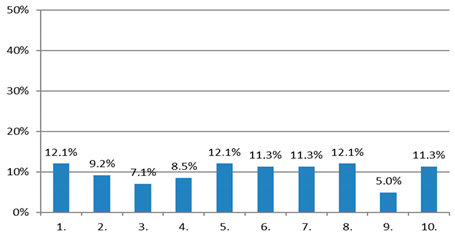 Likert Scale (1–10) | ||||
| Mean | Median | Minimum | Maximum | Standard Deviation |
| 5.5 | 6 | 1 | 10 | 2.9 |
| Sports events from the Poznan Half Marathon cycle cause inadequate supporters’ behavior in the city (e.g., loud behavior, fights, etc.) | ||||
| Half Marathon Athletes | N = 210 | % | ||
| Yes | 28 | 13.3 | ||
| No | 182 | 86.7 | ||
| Likert Scale | (N = 28) | |||
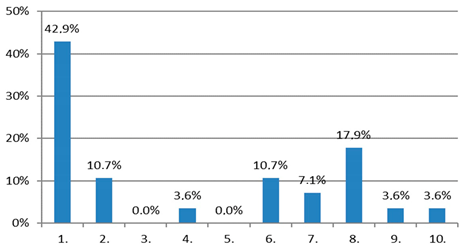 Likert Scale (1–10) | ||||
| Mean | Median | Minimum | Maximum | Standard Deviation |
| 4.0 | 2 | 1 | 10 | 3.3 |
| Sports events from the Poznan Half Marathon cycle cause an increase in crime in the city (e.g., thefts) | ||||
| Half Marathon Athletes | N = 210 | % | ||
| Yes | 21 | 10 | ||
| No | 189 | 90 | ||
| Likert Scale | (N = 21) | |||
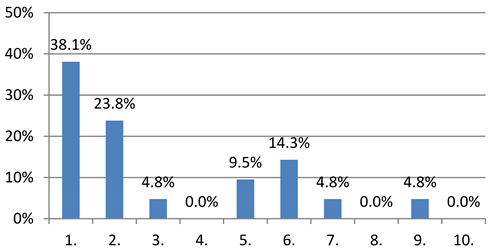 Likert Scale (1–10) | ||||
| Mean | Median | Minimum | Maximum | Standard Deviation |
| 3.1 | 2 | 1 | 9 | 2.5 |
| Satisfied with the organization of sports events in Poznan, bearing in mind the disadvantages of organizing events from the Poznan Half Marathon in the city. | ||||
| Half Marathon Athletes | N = 210 | % | ||
| Yes | 208 | 99.0 | ||
| No | 2 | 1.0 | ||
| Likert Scale | (N = 208) | |||
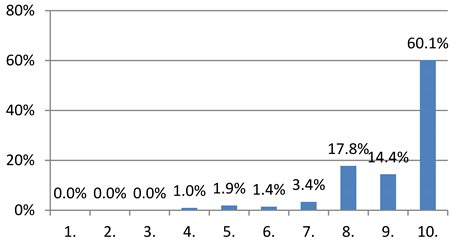 Likert Scale (1–10) | ||||
| Mean | Median | Minimum | Maximum | Standard Deviation |
| 9.2 | 10 | 4 | 10 | 1.3 |
| Bothersome Communication Problems (e.g., Additional Traffic Jams in the City) that Cause Sporting Events | ||||
| Half Marathon Fans | N = 256 | % | ||
| Yes | 160 | 62.5 | ||
| No | 96 | 37.5 | ||
| Likert Scale | (N = 160) | |||
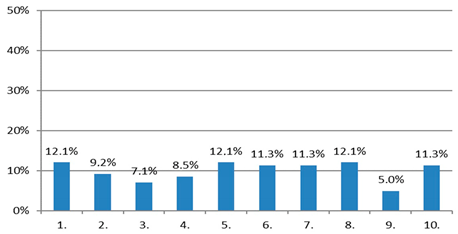 Likert Scale (1–10) | ||||
| Medium | Median | Minimum | Maximum | Standard Deviation |
| 5.5 | 6 | 1 | 10 | 2.7 |
| Sports Events from the Poznań Half Marathon Cycle Cause Inadequate Supporters’ Behavior in the City (e.g., Loud Behavior, Fights, etc.) | ||||
| Half Marathon Fans | N = 256 | % | ||
| Yes | 24 | 9.4 | ||
| No | 232 | 90.6 | ||
| Likert Scale | (N = 24) | |||
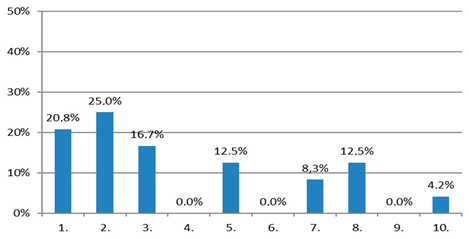 Likert Scale (1–10) | ||||
| Mean | Median | Minimum | Maximum | Standard Deviation |
| 3.8 | 3 | 1 | 10 | 2.8 |
| Sport Events from the Poznan Half Marathon Cycle Cause an Increase in Crime in the City (e.g., Thefts) | ||||
| Half Marathon Fans | N = 256 | % | ||
| Yes | 18 | 7.0 | ||
| No | 238 | 93 | ||
| Likert Scale | (N = 18) | |||
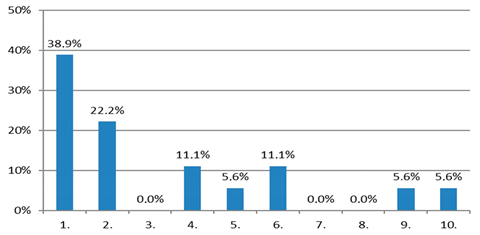 Likert Scale (1–10) | ||||
| Mean | Median | Minimum | Maximum | Standard Deviation |
| 3.3 | 2 | 1 | 10 | 2.9 |
| Satisfied with the Organization of Sports Events in Poznan, Bearing in Mind the Disadvantages of Organizing Events from the Poznan Half Marathon in the City. | ||||
| Half Marathon Fans | N = 256 | % | ||
| Yes | 252 | 98.0 | ||
| No | 4 | 1.6 | ||
| Likert Scale | (N = 252) | |||
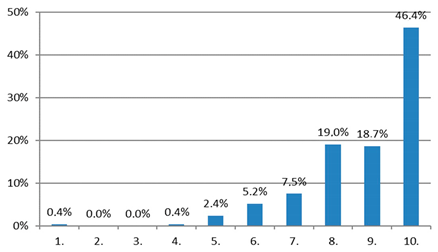 Likert Scale (1–10) | ||||
| Mean | Median | Minimum | Maximum | Standard Deviation |
| 8.8 | 9 | 1 | 10 | 1.5 |
| Bothersome Communication Problems (e.g., Additional Traffic Jams in the City) that Cause Sporting Events | ||||
| Cavaliada Fans/Residents of Poznan | N = 308 | % | ||
| Yes | 97 | 31.5 | ||
| No | 211 | 68.5 | ||
| Likert Scale | (N = 97) | |||
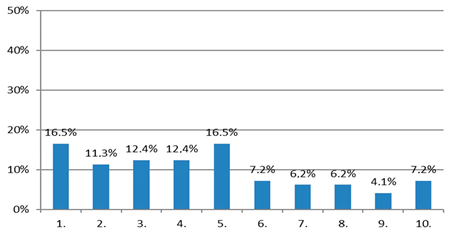 Likert Scale (1–10) | ||||
| Mean | Median | Minimum | Maximum | Standard Deviation |
| 4.5 | 4 | 1 | 10 | 2.7 |
| Sports Events from the Poznan Cavaliada Cycle Cause Inadequate Supporters’ Behavior in the City (e.g., Loud Behavior Fights, etc.) | ||||
| Cavaliada Fans/ Residents of Poznan | N = 308 | % | ||
| Yes | 19 | 6.2 | ||
| No | 289 | 93.8 | ||
| Likert Scale | (N = 19) | |||
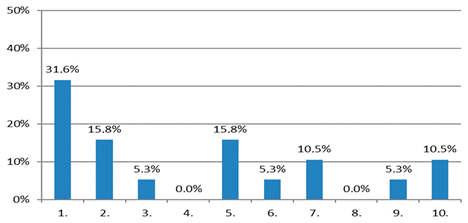 Likert Scale (1–10) | ||||
| Mean | Median | Minimum | Maximum | Standard Deviation |
| 4.2 | 3 | 1 | 10 | 3.2 |
| Sports Events from the Poznań Cavaliada Cycle Cause an Increase in Crime in the City (e.g., Thefts) | ||||
| Cavaliada Fans/ Residents of Poznan | N = 308 | % | ||
| Yes | 16 | 5.2 | ||
| No | 292 | 94.8 | ||
| Likert Scale | (N = 16) | |||
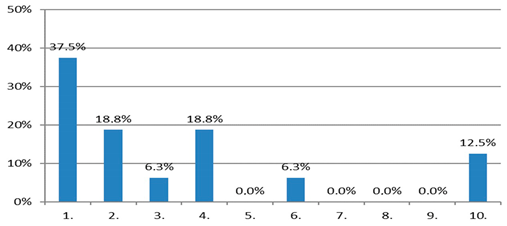 Likert Scale (1–10) | ||||
| Mean | Median | Minimum | Maximum | Standard Deviation |
| 3.3 | 2 | 1 | 10 | 3.0 |
| Satisfied with the Organization of Sports Events in Poznan, Bearing in Mind the Disadvantages of Organizing Events from the Poznan Half Marathon in the City | ||||
| Cavaliada Fans/Residents of Poznan | N = 308 | % | ||
| Yes | 302 | 98.0 | ||
| No | 6 | 2.0 | ||
| Likert Scale | (N = 302) | |||
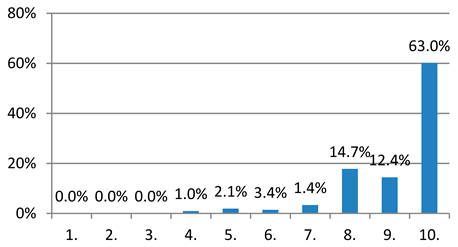 Likert Scale (1–10) | ||||
| Mean | Median | Minimum | Maximum | Standard Deviation |
| 9.0 | 9 | 4 | 10 | 1.2 |
© 2020 by the authors. Licensee MDPI, Basel, Switzerland. This article is an open access article distributed under the terms and conditions of the Creative Commons Attribution (CC BY) license (http://creativecommons.org/licenses/by/4.0/).
Share and Cite
Poczta, J.; Dąbrowska, A.; Kazimierczak, M.; Gravelle, F.; Malchrowicz-Mośko, E. Overtourism and Medium Scale Sporting Events Organisations—the Perception of Negative Externalities by Host Residents. Sustainability 2020, 12, 2827. https://doi.org/10.3390/su12072827
Poczta J, Dąbrowska A, Kazimierczak M, Gravelle F, Malchrowicz-Mośko E. Overtourism and Medium Scale Sporting Events Organisations—the Perception of Negative Externalities by Host Residents. Sustainability. 2020; 12(7):2827. https://doi.org/10.3390/su12072827
Chicago/Turabian StylePoczta, Joanna, Agata Dąbrowska, Marek Kazimierczak, François Gravelle, and Ewa Malchrowicz-Mośko. 2020. "Overtourism and Medium Scale Sporting Events Organisations—the Perception of Negative Externalities by Host Residents" Sustainability 12, no. 7: 2827. https://doi.org/10.3390/su12072827
APA StylePoczta, J., Dąbrowska, A., Kazimierczak, M., Gravelle, F., & Malchrowicz-Mośko, E. (2020). Overtourism and Medium Scale Sporting Events Organisations—the Perception of Negative Externalities by Host Residents. Sustainability, 12(7), 2827. https://doi.org/10.3390/su12072827






